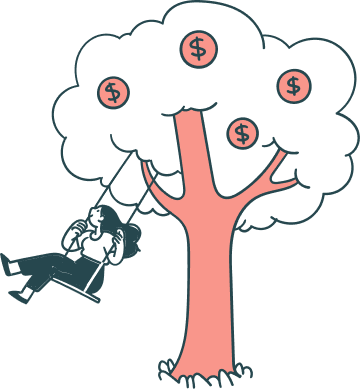How to Make Your Fundraiser a Success
New and growing nonprofit organizations often wonder how to prioritize the competing demands of board development, fundraising, programming, and marketing while working on a shoestring budget. My advice? Start with a fundraising plan — a document that organizes your fundraising goals, objectives, and strategies over a defined period.
Developing diversified, sustainable funding helps organizations withstand the inevitable ups and downs of the nonprofit lifecycle. Economic downturns, drops in board giving, changes in federal funding, etc., can quickly sink the ship unless your organization plans for them in advance.
Think of a fundraising plan as a lifejacket: – make sure to have it on board before you hit rough waters.
Additionally, a fundraising plan ensures that your organization can capture and hold the attention of donors. With 1.5M+ nonprofits in the United States, standing out from the crowd can be tough. Show potential supporters that you can maximize the impact of their gifts and can responsibly manage donations by developing a realistic, well-researched fundraising plan.
From schools to nonprofits, fundraising success depends on your ability to create an effective strategy. Fundraising plans include more than well-wishes and a quick meeting; they require in-depth knowledge of your organization and its needs, capacity, budget, calendar, and donor base. But don’t worry, a fundraising plan doesn’t have to be complicated. Follow these six simple ways to get started writing your fundraising plan.

Step 1: Create Effective Fundraising Goals and Strategies
Whether you have well-established annual or semi-annual fundraisers, or want to do something new, you should always set goals and strategies at the beginning of your fiscal year. To understand what your organization stands to gain, you must break down the goals and objectives into measurable pieces through strategic planning.
Strategic planning is the foundation of a solid fundraising plan and includes specific numbers, markers, goals, and objectives for your fundraiser.
It’s not enough to say, “I want to make money by the end of this effort”. That’s too vague and not measurable. Instead, try saying “By day three I want to make ¼ of our overall goal of $300,000.”
Including specific goals and markers from the beginning effectively measures where your campaign is and where you need to go. This is the primary step to creating a measurable fundraising strategy.
Strategic planning also includes understanding your target audience through market research. Ideally, your organization already has a donor base from which to pull. If not, market research becomes critical to ensuring the success of your fundraiser. Your organization’s life cycle placement will determine the importance of market research. Unless you are a new organization or are doing a major re-brand, you should be aiming to retain your donors. This will determine much of your strategy.
After setting your organization’s goals and creating measurable markers, you can look into effective campaign ideas and best practices to create the actual strategy. This means utilizing the who and what to find the how. This is where you choose the best approach to creating your fundraiser, and requires asking questions like:
- Will online or in-person work better?
- How long do you need?
- How will you market?
- How much money or time can you devote to it?
The strategy informs the rest of the campaign, making it a crucial first step towards a successful fundraiser.
Take a Personalized Tour
Schedule a demo with one of our fundraising consultants. We’ll show you how the Snowball platform has benefited other nonprofit organizations, and how it can help you.


Step 2: Focus on Capacity Planning
Capacity planning creates a solid foundation for a successful and sustainable fundraiser. To determine your organization’s capacity:
- First, determine the requirements of your fundraiser.
- Next, analyze the current capacity to complete it.
- Finally, plan for the future.
Capacity planning includes analyzing your available workforce, resources, and organizational capacity. This will determine what you have, what you need, and what you would like to have in the future.
For example: Boutique bakery Cake for Babes decided to do a bake sale fundraiser benefiting premature babies’ hospital funds. If they had included capacity planning in their original plan, they would have noticed that they did not have the necessary number of staff for the event. This meant they did not campaign for a higher number of volunteers, leading to a lot of confusion, little training, and more customer complaints. Next time, Cake for Babes will include capacity planning and will have the required workforce for their event.
Remember that capacity planning and building is an investment that will aid the longevity of your organization. You can do an informal or formal analytics report to determine what you need, what you have, and what you are missing. This will then inform your overall fundraising plan.
Things to consider while building your capacity plan include:
- Governance
- Financial management
- Evidence-based programming
- Strategic planning
- Evaluations
It is important that your organization’s capacity also includes cultivating a fundraising culture. This means involving your staff, board, and donors in fundraising efforts. Including everyone in fundraising impacts, challenges, and successes ensures they remain invested in your organization’s efforts; this will have long-term positive impacts.

Step 3: Build a Fundraising Calendar
Building a fundraising calendar leads to a sustainable fundraising plan. Creating and executing a fundraiser involves a lot of work, communication, and effort. Complexity rises when more people or organizations become involved. Having a calendar keeps everyone on track and allows you to measure the progress you set in your goals and strategies.
A fundraising calendar should summarize everything your team needs to do to raise money, retain donors, attract new donors, and benchmark your progress.
First, gather key dates, such as your fiscal year, and write out anything already planned for the year (i.e., hard deadlines, unlikely to change). Next, make a list of what you will need and what projects you hope to complete next year. Finally, customize your calendar to fit your needs throughout the year.
At the end of your campaign, you can see what worked and what did not. If you want to do that particular fundraiser again, you can improve the calendar for the following campaign.

Step 4: Plan Your Funding
Fundraising plans should include the type of funding your organization will target. Your campaign depends on many factors. Funding is one of the primary components that determines your overall strategy. The type of funding you’re targeting will determine who your target audience is, what your goals are, what you hope to achieve, and how you need to achieve them.
For example: Your organization needs $10,000 for marketing. However, your campaign efforts focus on speaking to the individuals in your community. The community proceeds to donate, but you only receive $1,500. You should always aim to include the community, but in this case you should apply for a grant. Grants provide a specific sum of money upfront while the community gives as they can.
Funding sources can include, but are not limited to:
- Grants
- Sponsors
- Corporate
- Events
- Planned giving
- Individuals.
These funding types all have different requirements. Some, like grants, will need an application. Others may require you to track whether gifts to your organization were donated virtually or in-person from recurring donors, new donors, one-time donors, or recurring donors. Note that planned giving depends on how established your organization is and on the strength of your donor relations.

Step 5: Create a Budget
Creating a fundraising plan means having a budget in place. This will determine how much money you are willing to put into the campaign and where you want to spend it. Taking a comprehensive view of your fundraiser includes looking at the associated expenses, comparing them to a realistic estimate of potential earnings, and determining if it will lead to a sustainable outcome.
When writing your budget, start with your expenses (costs) and then add in expected revenue (anticipated funds). Utilize your past fundraising efforts to create the best estimate possible. To help, split expenses into annual costs and one-time investments. From there, you can cut costs, prioritize, re-organize, and “wishlist” unnecessary expenses. This will help you prioritize during the planning process.
Keeping track of your fundraiser budget before, during, and after your campaign can also help you in the future. You will have an easier time keeping track of your expenses and revenue, comparing your total losses and gains, and prioritizing necessities versus wish lists. In short, it will help you measure your fundraiser’s success in accordance with your goals and objectives.
Step 6: Aim to Retain

“Think of your fundraising efforts as a bucket and your donors as water,” Classy explains. “If your bucket has too many holes in it, your donors will slowly trickle out.” Focusing too much on bringing in new donors can cause holes in your bucket.
This is where having a solid fundraising plan comes into play. Strategies to maintain donors include relationship building, investing in data and technology, asking for feedback, demonstrating your impact, and showing appreciation.
Donor-organization relationships should be a cycle that starts with the ask, goes to the donation, moves to appreciation, and returns to the ask. Ideally, donor-organization relationships should not be a single interaction. To build an engaged and connected base of supporters, your donor engagement strategy needs to be an ongoing priority.
If you are still not convinced, remember that donors will not return for future campaigns if they are no longer invested in your cause or feel unappreciated. Investing in retention ensures you can study donor tendencies and appeal to their interests.
The time and research needed to write an effective fundraising plan pays off. With these six steps, you and your team now have the necessary steps to create an effective strategy to develop a stronger understanding of capacity, foster relationships with your donors, learn how to set realistic bencharks, anmarks, and build a sustainable organization. Go get started!
Take a Personalized Tour
Schedule a demo with one of our fundraising consultants. We’ll show you how the Snowball platform has benefited other nonprofit organizations, and how it can help you.




